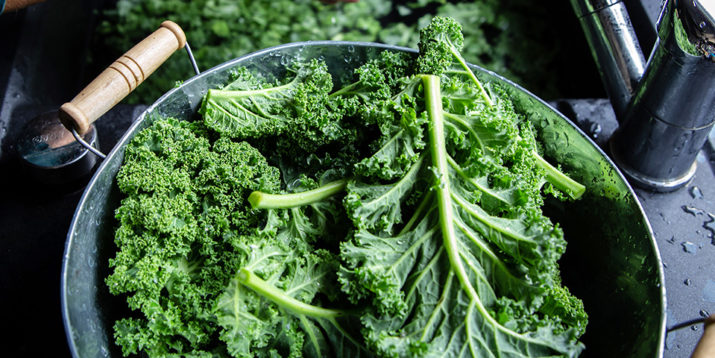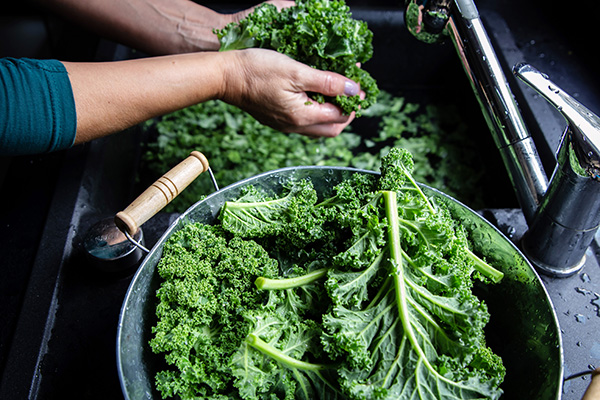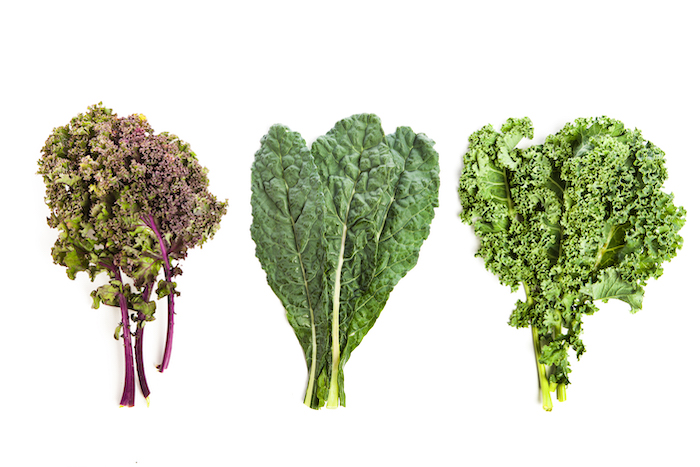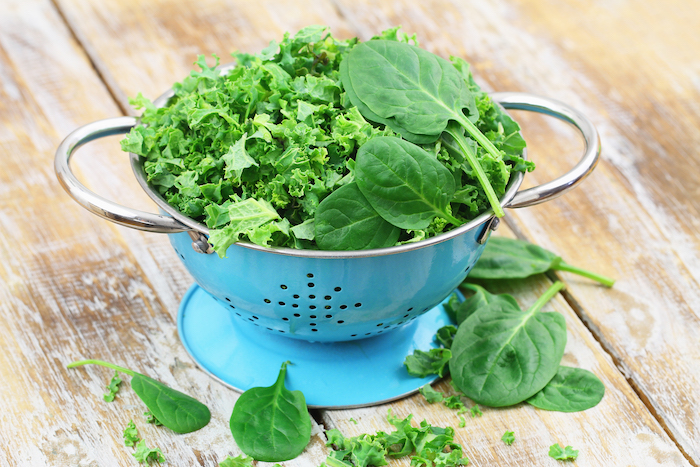Everything You Need to Know About Kale

Kale remains one of the most hyped-up foods in the health community. Dietitians, marketers, and recipe developers all claim kale is a nutritional powerhouse (#kaleyeah!) — but why? What exactly is in kale that makes the veggie so nutrient-rich?
To demystify the beloved leafy green, we’re going to break down its exact nutritional value. First, though, let’s address a common question: Is kale a superfood?
Is Kale a Superfood?
The definition of a superfood varies depending on the person you’re talking to. However, if you consider a superfood a nutrient-dense food that has proven health benefits, then kale definitely qualifies.
“Kale is about as good as it gets for overall nutrient richness,” says Jackie Newgent, R.D.N., culinary nutritionist, and author of The Clean & Simple Diabetes Cookbook.
Kale Nutrition Facts

Like other dark leafy greens, kale is easy to eat in volume, especially if it’s cooked down to a more compact size.
However, a standard serving is one cup of cooked kale or two cups of raw kale, says Jennifer Glockner, R.D.N., and creator of Smartee Plate.
Boasting a slightly earthy flavor, kale is chock full of vitamins and nutrients and clocks in at just 9 calories per cup (raw).
Most notably, according to the USDA, kale has plenty of vitamin K, vitamin C, vitamin A, folate, calcium, and magnesium.
Interestingly, when you cook kale, the value of some nutrients increases, while others decrease.
Two cups of raw kale contain:
| Calories | 15 |
| Carbohydrates | 2 g |
| Fiber | 2 g |
| Protein | 1 g |
| Calcium | 105 mg |
| Magnesium | 14 mg |
| Phosphorus | 23 mg |
| Potassium | 144 mg |
| Vitamin C | 38 mg |
| Folate | 26 mcg |
| Vitamin A | 100 mcg |
| Vitamin K | 160 mcg |
| Zinc | 160 mcg |
| Iron | 660 mcg |
By contrast, one cup of cooked kale contains:
| Calories | 42 |
| Carbohydrates | 6 g |
| Fiber | 5 g |
| Protein | 3 g |
| Calcium | 177 mg |
| Magnesium | 30 mg |
| Phosphorus | 50 mg |
| Potassium | 170 mg |
| Vitamin C | 21 mg |
| Folate | 77 mcg |
| Vitamin A | 172 mcg |
| Vitamin K | 494 mcg |
| Zinc | 319 mcg |
| Iron | 991 mcg |
Let’s review what some of the key vitamins, minerals, and nutrients in kale actually do for your body.
1. Vitamin C
“Vitamin C is an antioxidant that’s important for skin health, wound healing, and iron absorption,” says Newgent.
Vitamin C helps synthesize collagen, a protein that’s an essential part of your skin and connective tissue like tendons and ligaments. Plus, vitamin C has long been reported to help boost your immunity, says Glockner.
According to the 2015–2020 Dietary Guidelines for Americans, the recommended dietary allowance (RDA) for vitamin C is 75 to 90 milligrams a day for adults.
One cup of cooked kale has 21 milligrams of vitamin C, which is nearly 30% of your daily intake.
2. Folate
Folate is a B-vitamin that helps make new cells in the body, Newgent says. “For pregnant women, it’s especially important for prevention of birth defects associated with the brain and spine,” she explains.
The RDA for folate varies by age, but most adults should aim to consume 400 micrograms a day
. Anyone who is pregnant or breastfeeding should aim for 600 micrograms a day.
With 77 micrograms of folate, one cup of cooked kale provides almost 25% of your daily intake.
3. Vitamin K
Vitamin K is a fat-soluble vitamin that helps keep your tissues and bones healthy, says Newgent.
If a vitamin is fat-soluble — as opposed to water-soluble — it means your body needs healthy fats to help absorb the vitamin properly.
Once your body absorbs fat-soluble vitamins, it stores them in your liver and fatty tissues.
Vitamin K isn’t just good for your tissues and bones, though. It also helps prevent blood clotting, says Glockner.
The RDA for vitamin K for adults is 90 to 120 micrograms per day. One cup of cooked kale has almost 500 micrograms of vitamin K, whereas a cup of raw kale contains 82 micrograms.
4. Antioxidants
“Kale is packed with powerful antioxidants, including quercetin, lutein, and zeaxanthin,” says Newgent.
Along with beta carotene, lutein and zeaxanthin are carotenoids that are believed to maintain the health of your eyes and vision as you age.
Another antioxidant present in kale is vitamin A, which has a similar function.
“Vitamin A plays a vital role in your vision,” says Newgent, “as well as the functioning of cells and your immune system.”
Getting enough vitamin A in your system may also help improve your skin and hair health, too, adds Glockner.
The recommended amount of vitamin A is 700 to 900 micrograms of retinol activity equivalents (RAE) a day. One cup of cooked kale contains 172 micrograms RAE.
5. Calcium
“Calcium is the most prevalent mineral in our bodies,” says Glockner. Along with phosphorus, she explains, calcium helps improve our bone and tooth health. “Calcium is also important for heart health and muscle contractions,” she adds.
Adults should aim to consume 1,000 milligrams of calcium per day; growing teens and adolescents should shoot for 1,300 milligrams.
One cup of cooked kale gives you 177 milligrams of calcium, which is nearly 20% of your daily intake.
6. Fiber
Fiber has a plethora of important functions for the body. Fiber helps promote better gut health, says Glockner, and adds bulk to your stools, making them easier to pass.
Plus, “Fiber keeps the tummy full longer,” she explains, “which can prevent overeating at the next meal.”
Fiber can also help regulate your blood sugar levels and prevent extreme highs and lows, Glockner adds, since it slows down the rate of glucose absorption.
One cup of cooked kale has nearly five grams of fiber, which is about 20% of the RDA for adults (25 grams of fiber for women and 30 grams for men).
Kale Health Benefits

We know that kale is good for you, but what do all these specific vitamins and minerals really do for your body?
Registered dietitian Brit Giles, R.D.N., says, kale “contains powerful antioxidants, as well as fiber to prevent disease and keep the gut happy.”
1. Provides antioxidants
Kale is a rockstar when it comes to antioxidants, but according to studies, some of those antioxidants do lessen when the veggie is cooked, especially vitamins C and vitamin K.
You can enjoy kale raw or cooked like in this Toasted Kale Salad.
Similarly, other leafy greens also have plenty of antioxidants, like spinach, so aim for a variety of veggies in your daily greens.
2. May support eye health
Vitamin A is essential for keeping your eyesight in top shape, as well as supporting your immune system.
3. May aid in bone health
Research has shown that vitamin K can help with overall bone health.
How Much Kale Should You Eat?
According to the 2020-2025 Dietary Guidelines for Americans, your aim should be about 1 ½ cups of dark green vegetables, like kale, per week.
“You can get plenty of nutrients in just 1-2 cups of raw kale,” Giles says. “There’s not really a limit. However, it’s best to get a variety of veggies throughout the day.”
If you’re on blood thinners or anticoagulant medication, you can still enjoy kale, but do it in a consistent manner. Kale is rich in Vitamin K, which has proteins that aid in clotting blood.
As always, consult your doctor or physician when changing any part of your health routine.
Types of Kale

Don’t get discouraged if one type of kale isn’t your jam. There are at least three main types of kale you’ll find at the grocery store and plenty of tasty ways to prepare them!
“The healthiest dark leafy greens are the ones that you’ll actually eat,” says culinary nutrition specialist Quyen Vu.
Curly kale
Curly kale is the most common kale you’ll find and is great for most recipes, like Vegan Kale Nachos or an Egg White Kale Pizza.
If you’ve got a large bag and it’s about to go bad, just freeze it to grab a handful or two for a morning smoothie.
Lacinato or dinosaur kale
This type of kale is a bit firmer than your curly kale, with leaves that look almost scaly and have a dark blue-green color.
Each stalk is a bit longer and thinner than your regular curly kale and is often a good option for kale chips.
Red Russian kale
Red Russian has leaves that are shaped much differently than the other varieties, as they look almost like oak leaves but have slightly purple stems and reddish leaves.
Use this kale in salads, for garnish, or to add to sandwiches as the taste is overall sweeter than the other types of kale.
How to Prepare Kale
If you are going to eat kale raw, Vu recommends a simple salad with a lemon vinaigrette dressing and a sprinkle of parmesan cheese.
You can add some lean protein, like grilled chicken, to make it an easy, light meal.
If you opt for cooked kale, Vu recommends kale chips for a salty, crunch (and healthy!) snack or to sauté kale with a little bit of maple syrup, salt, pepper, and diced onions in a skillet on medium heat. Cook everything until it softens.
“Baby kale tastes less bitter than fully grown kale, and removing the stems and only eating the kale leaves would make the taste milder,” she explains.

Which Is Healthier: Spinach or Kale?
When it comes to leafy greens, spinach and kale reign supreme. But is one leaf healthier than the other? Glockner says no.
“One is not a better option than the other. They just have different nutrient and taste profiles,” she says. For example, “Kale is higher in vitamin C, calcium, and fiber,” she says, “while spinach is higher in iron, potassium, and vitamins A and K.”
Eating spinach and kale is a good idea if you want to score as many nutrients as possible for a low-calorie count.
“The more vegetable variety you get,” Newgent says, “the more variety of nutrients you get.”
